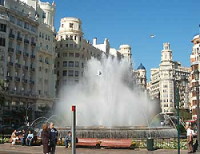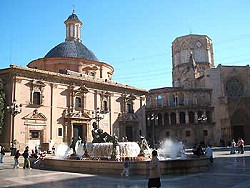
Photo. Plaza del Ayuntamineto in Valencia. © Alex Welsh, Valencia Tourist Information, Spain - www.valenciavalencia.com.
Valencia leaves you perplexed. When you see the vastness of its treasury, you can’t help but looking for a catch. Valencia is such a multi-dimensional city, truly sporting everything you could ever ask for from a destination (and at a top scope and level, not just a promotional token), that you simply feel lucky to have found it on your way. Many of the much more popular European locations don’t have a half of what Valencia has, yet here it is all business as usual, consuming you into its culture, forcing you to leave yours behind and truly banning all tourist conventions. This is a real journey and definitely one of Europe’s best kept secrets.
The basic attraction of any European city is its historic core – the Old Town. Valencia’s is a rich kaleidoscope of styles, spanning 8 Christian centuries of its history. Not just architecture on the streets, but spectacular monuments worthy of any important European city – two pairs of gigantic Gothic city gates, a Gothic castle-like palace, gorgeous Basilica – one of the first Baroque buildings in Europe, elaborate Cathedral sporting a mixture of styles and cultures (plus the only viable claim in the world to hosting the Holy Grail), and not to forget La Lonja – one of the most spectacular European Gothic structures protected by UNESCO. There are even Roman ruins. These are just some of the highlights amongst a myriad of other beautiful churches and building from all epochs.
These riches reflect Valencia’s history – it is a place that has always been a city, ever since the concept of the city was formed in the early Middle Ages. A curious place, Valencia has always been somewhat of a runner up – perhaps not one of the major European centres but definitely one of the most forward-looking and dynamic ones. The printing place entered Spain through Valencia, the Renaissance had its first Spanish roots here, the Enlightenment found its Spanish core here, the shock of the French Revolution was felt here the most, the coronation of the first constitutional monarch in the First Spanish Republic took place here, and it was here that the Second Republic centralised to fight Franco in 1930s. And in the 15th century – the Golden Age of Valencia – it was the most populous, prosperous and cultural city in the whole of Europe.
Yet when you walk around all this legacy here, there is no sense of distance, like in many other destinations. Here you remain close. On the streets it is business as usual, as if the time stopped a few centuries ago. Full of cosy corners and genuine snapshots of the past, the Old Town is an insane maze of old Arabic streets. It’s impossible not to get lost but you accept this fate easily, for you will be rewarded with stunning finds all the way and the surprise element makes your walk that much exciting.
Part of Valencia’s charm is how green it is. I have heard it is one of the greenest cities in Europe. There is always some kind of park, garden, shady alley, anywhere you go. And the city is split in half by 9 km of a wide green belt – the Turia Garden which used to be a river until it got diverted. The calm and tranquillity of a sunny Spanish afternoon in that river of greenery, right in the middle of this metropolis, is the essence of Valencia. Valencia is also called the City of Flowers – they are abundant everywhere and the locals make incredible things out of them for their many fiestas.
They also call Valencia the City of Contrasts. Ancient monuments in the centre are interspersed with some of the most spectacular and imaginative XIX and XX century architecture. Even deeply residential districts tend to sport something curious on their apartment blocks. In the recent years a whole range of purely futuristic buildings has sprung up, culminating with the mind-bogglingly ambitious City of Arts and Sciences.
This thing, built by Santiago Calatrava, is an enormous educational-leisure complex, that would have been selected as one of the New Wonders of the World, had it been completed in time for nominations. A totally unique idea, it takes you right into the 23rd century – onto some distant space base. Gigantic futuristic shapes are surrounded by crystal clear water. And if you keep in mind that Calatrava bases his designs on skeletons, this becomes an insane intergalactic graveyard of giant alien creatures. More than just a pretty face, the City hosts the biggest marine wildlife park in Europe, an ultra-interactive science museum, an IMAX cinema and an opera house.
There are cities, like London or Paris, that embody the individual culture of that nation. Then there are cities, like Jerusalem or Istanbul, which embody the constant flux of cultures in mankind. Valencia is one of those. Built by the Romans and taken over by the Visigoths, it later flourished under the Moors (Muslims) for 6 centuries until it was finally re-built by Christians.
Yet, curiously, throughout this process a strong Valencian cultural identity emerged in, once again, the City of Contrasts. The locals see themselves as an ethnic kingdom within Spain. What is spectacular, though, is that here the traditional is still very much in fashion, preserved mainly in music, costumes, customs and fiestas. A good third or so of Valencia proudly sports regional costumes (said to be the most colourful in Spain) and music on even the smallest occasion. That includes a lot of youth. Here, it is still cool to be traditional in the 21st century.
These are falleros – neighbourhood co-operatives, unique to Valencia in the whole world. It is a bizarre concept – clan-like, almost tribal conglomerations, reminiscent of Medieval Muslims, they are the core of the city, usually uniting for Catholic fiestas. There are around 350 of fallas (co-operatives) and they have their heyday every year in the middle of March, for 5 days of urban insanity named Las Fallas.
Huge and colourful effigies (monuments, sculptures) get built from wood and papier-mâché on the streets of Valencia, around 800 in total, some as high as 25-30 metres. They are usually satirical or provocative in their content. The whole city dresses up into traditional costumes and takes to the streets with music and war zone level of fireworks. Paella is cooked all over the streets, the crowds party until dawn and on the last day all those effigies get burned.
But that’s not all of it. There is always some kind of fiesta in Valencia. The locals love noise, spectacle and party. Fireworks and petards are kept in kitchen cupboards for daily use here. You get an impression they spend the whole year making costumes, spectacles, floats etc for all those colourful fiestas. And there is always plenty of music if you like Spanish wind and percussion – they call Valencia the Vienna of Spain.
All this love for noise and party doesn’t just stay in the traditional. The Valencians are some of the most hardcore party animals in Spain and the nightlife here is nationally famous, going well until dawn (and in some places until lunchtime!). They say people here go out from Monday to Sunday. There are myriads of bars, discos and night clubs, as well as concerts and live music nights.
The culture doesn’t stay in the traditional either. The City of Valencia seems to be hell bent on not letting Valencia turn into another Benidorm. More and more, Valencia gets to be in the circuit of world music, arts and cultural events. There is always something going on here, a truly cosmopolitan and avante-guard spectrum of events. Add to it scores of museums, theatres, art galleries, classical music venues resident in Valencia, and you really don’t have an excuse to be bored.
And yes, there is a beach, and it’s about the best city beach I have ever seen. It might not be a deserted island, but it is large enough, clean enough and lively enough, plus the climate is amazing, the water is great and the sand is of top quality. Just to think that it is a mere 20 minutes from all the sightseeing and culture in the centre…And right there on the beach you can have the famous Valencian cuisine. Paella is a Valencian invention and here you can have the best of the best.
Yet with all of this, with all its buzz and ambition, and a million things to offer, Valencia remains cosy and warm and friendly and laid back. The people are still very welcoming and open, and the city injects a good dose of tranquilliser into your veins as soon as you step off the plane. They call Valencia “the biggest Spanish village”. Quite extraordinary and totally incomprehensible. Perhaps it might not last long. We will have to see.
For now though, what else one could ask for from an urban destination?
This article continues in part 2: Valencia – The City That Has It All! Click on the link for reading more: Valencia - Part 2.
Alex Welsh, 29 May 2007
Additional information
Alex is the webmaster of Valencia Tourist Information - an independent resource on travelling in Valencia, Spain - www.valenciavalencia.com.













